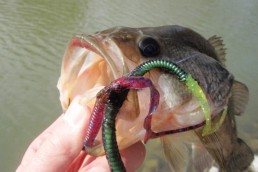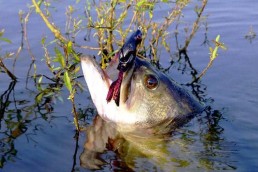July is the ‘Rat’ Time to Edge and Skim Thick Weeds
SHARE THIS POST
There are few angling experiences that I enjoy more than taking some good fish on topwater lures. Once the spring spawn has concluded and the fish are eager for sustenance, pike, largemouth and smallmouth bass, crappies and even rock bass seem eager to tangle themselves upon the treble hooks when they are hungry and aggressive. The great thing about topwater fishing is that it continues throughout the summer and right into fall. Even though July and August are traditionally when weed growth is at its “ugliest”—with farm ponds and small lakes so weed-choked that normal angling methods seem impossible—the topwater bite can be very effective.
How can this be?
The answer is to fish parallel to the weed edges or right on top of them.
Very few bodies of water ever become completely weed-choked. As long as there are open pockets in the lake or pond, the fish can be caught. In these situations, I prefer to use some of the older baits such as the Jitterbug, the Hula Popper, the Smithwick Devil’s Horse, the Neal Spinner, the Rapala Original Floater and the Rebel Pop-R. Predators like largemouths lurk beneath the weed mats and patrol the outer edges searching for anything that appears to be edible. Plunk one of these lures down, wait for the ripples to subside and give it a twitch. If nothing happens, twitch it again, and then again. Barring an explosive strike that sounds like a watermelon rolling off a wagon and landing, and if there is enough water to do so, begin a slow, steady retrieve. When nothing happens and the edges of the weeds have been passed, flip the lure up out of the water and repeat the process. Any of these lures, even the Jitterbug, can be twitched in place. Even if no fish strike, believe me, at least one or two are watching.
Are you enjoying this post?
You can be among the first to get the latest info on where to go, what to use and how to use it!
When all else fails, take your war to the weeds. Choose heavy equipment and strong braided line and tie on one of the very specialized lures made for weed fishing. I’m talking about the famous “rat” lures, the floating frogs, the lizards and snakes. The rats and frogs are the hollow-bodied, soft plastic lures constructed on weighted, upturned hooks that are made to be plopped down on the weed beds and retrieved across them. The lizards and snakes are soft plastic lures that can be Texas rigged and cast with no weight. For lizards, choose the 7- or 8-inch versions; for snakes, try those in a 10-inch configuration.
Using any of the four, land your lure on the weeds and let it set for at least 30 seconds. No strike? Begin a slow retrieve. For the frogs and rats, raise your rod tip and shake it sideways while retrieving to give the appearance of a small animal scurrying across the mats. For the snakes and lizards, just keep up a steady retrieve and the slithery lure will work its own magic. Expect a strike at any moment because bass have a propensity for bursting through the weeds, grabbing whatever has attracted their attention, and then burrowing back into the mess—prevent this, if at all possible. When the strike comes, pause for a fraction of a second until the weight of the fish is felt, and then set the hook as hard as you can. Keep the rod tip high and try to skate the fish across the surface. Usually, this can be done rather well unless you have connected with a real “hawg.” If so, wade into the shallows if you are fishing from the bank and retrieve the fish. When in a boat, try to move over the fish so you can reach straight down (avoiding the hooks) and grasp the fish.
This is one of my favorite methods of angling since there is nothing that matches the thrill of seeing a big bass shoot up through the weeds, shake its head and rattle its gill plates while trying to throw the lure. I don’t win nearly all of the battles, but the fight certainly is worth it.
So, for the summer and fall season, don’t give up on topwaters and keep casting.
MWO
SHARE THIS POST
Did you enjoy this post?
You can be among the first to get the latest info on where to go, what to use and how to use it!
John Bennett
John Bennett is a retired history teacher, historical re-enactor, father and grandfather. As a four-season outdoorsman, his passion is waterfowl hunting and fishing for smallmouth bass. He lives in Ohio and spends quite a bit of time in his primitive log cabin, which he built.


